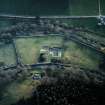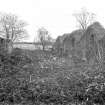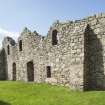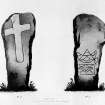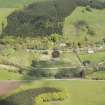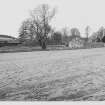Deer Abbey
Abbey (Medieval)
Site Name Deer Abbey
Classification Abbey (Medieval)
Alternative Name(s) Old Deer Abbey; Cistercian Abbey Of Deer
Canmore ID 20582
Site Number NJ94NE 5
NGR NJ 96855 48107
Datum OSGB36 - NGR
Permalink http://canmore.org.uk/site/20582
First 100 images shown. See the Collections panel (below) for a link to all digital images.
- Council Aberdeenshire
- Parish Old Deer
- Former Region Grampian
- Former District Banff And Buchan
- Former County Aberdeenshire
NJ94NE 5.00 96855 48107
NJ94NE 5.01 NJ 97007 48133 Walled Garden
NJ94NE 5.02 96855 48107 Pictish Symbol Stone
(NJ 9685 4810) Abbey (NR) (Remains of)
OS 6" map (1902).
Reference (1952)
The Cistercian Abbey of Deer was founded in 1219. The secularization of the abbey began in 1543 and its lands erected into a barony in 1587.
The dismantling of the buildings seems to have begun about 1590. They have been reduced to little more than foundations except for the south range which still remains to a considerable height, although they were partly rebuilt in 1809.
W D Simpson 1952
Field Visit (17 April 1968)
Deer Abbey is as described by Simpson. There is no trace of the symbol stone.
Visited by OS (NKB) 17 April 1968
Excavation (1986)
An application to develop the land between the guardianship site and the estate wall prompted a small excavation to estimate the extent of medieval activity in that area. Some medieval features were found, particularly to S of the Abbey buildings and to W, where the line of the main drain was identified. To E of the Abbey there was no trace of structures, and it seemed that burials may have been confined to the guardianship area.
J A Stones 1986.
Watching Brief (April 2002)
NJ 968 481 Archaeological monitoring was undertaken in April 2002 at Old Deer Abbey during the initial phase of construction of a new wooden porch. Nothing of archaeological significance was found.
Archive to be deposited in the NMRS.
Sponsor: HS
G Ewart and D Stewart 2002.
Watching Brief (6 June 2011 - 8 June 2011)
NJ 9685 4816 A watching brief was maintained 6–8 June 2011 during the removal of a tree stump. There were no finds or features of archaeological significance other than deposits which may date to 19th-century landscaping.
Archive: RCAHMS (intended)
Funder: Historic Scotland
Kirkdale Archaeology, 2011
Information also reported in Oasis (kirkdale1-122357) 18 July 2012
Photographic Survey (19 August 2013)
Photographed on beahlf of the Buildings of Scotland publications 2013-14.
Excavation (24 June 2017 - 2 July 2017)
NJ 9672 4819 (Deer Abbey NJ94NE 5) The 24 June – 2 July 2017 season of research digs focused on the fields around Deer Abbey, and Rose Geophysical Consultants also carried out survey work.
Four trenches targeted possible structures in the field to the W of the Abbey. The two northern trenches were located on higher ground above South Ugie Water and both contained remains of circular structures. Structure 1 was a series of postholes with a raft of stone on top. Pottery from the raft included 12th–14th-century medieval pottery and a group of hand-made pottery sherds. Residue on one of the hand-made sherds was dated 1276–1395AD. Structure 2 included a hearth dated 1147–1250AD from charcoal. On the N side of the hearth was a shallow ditch, which contained a number of stakeholes suggesting a wattle structure or windbreak had been located to protect the hearth. It is hoped to return in 2018 and further excavate Structure 1 to get dating evidence for the earlier building. These structures may be associated with the monastery where the Book of Deer was annotated in early Gaelic around 1000AD or may
be structures associated with the abbey which was founded in 1219AD. School classes, local volunteers, students and archaeologists participated in this dig. The whole excavation was filmed by Midas Media for BBC Alba.
Archive: NRHE
Funder: The Book of Deer Project
Alison Cameron - Cameron Archaeology
(Source: DES Volume 18)
Project (27 March 2017 - 5 April 2017)
NJ 96855 48107 (NJ94NE 5) A programme of geophysical survey was undertaken, 27 March – 5 April 2017, within and around Deer Abbey, a Cistercian establishment founded in 1219. The abbey’s history is not well understood but the community could never have been large. In 1544 an abbot and 11 monks were recorded. The abbey fell into disrepair in the late 16th century, being partially dismantled from c1590. In 1809 the ruins were cleared of rubbish and repaired by James Ferguson of Pitfour with the S range being partially rebuilt. In 1854 this was largely destroyed by Admiral Ferguson in order to build a mausoleum in the grounds. In 1930, the remains were bought by the Roman Catholic Church who gave custody to the Ministry of Works. The mausoleum was removed and the abbey repaired and laid out as it is seen today.
The survey was undertaken in two stages. Stage one within the HES PIC boundary which covers the 0.64ha area of the extant remains of Deer Abbey. Stage two over the c3.5ha of adjacent fields, which lie within boundary walls erected by Ferguson. The resistance and GPR survey of the HES PIC area identified several anomalies of possible archaeological interest, with data from both surveys dominated by paths dating from the late 1700s. There is some correlation between the resistance and the GPR data particularly within the SE of the survey area where anomalies suggestive of buried remains associated with the abbey have been detected. Anomalies and trends have been noted within the church which may be of archaeological interest, although interpretation is tentative given the past excavation at the site.
Within the wider area of the orchard and gardens the resistance survey data are dominated by responses from the 1700s paths. Additional anomalies have also been noted, particularly in the N of the area, some of which show some correlation with buildings depicted on plans from the late 1700s/early 1800s. Additional anomalies are also evident in the NE of the orchard area.
Archive: Rose Geophysical Consultants
Funder: Cameron Archaeology/Book of Deer Project
Susan Ovenden – Rose Geophysical Consultants
Ground Penetrating Radar (27 March 2017 - 5 April 2017)
NJ 96855 48107 (NJ94NE 5) Ground penetrating radar survey.
Archive: Rose Geophysical Consultants
Funder: Cameron Archaeology/Book of Deer Project
Susan Ovenden – Rose Geophysical Consultants
Earth Resistance Survey (27 March 2017 - 5 April 2017)
NJ 96855 48107 (NJ94NE 5) Resistance survey.
Archive: Rose Geophysical Consultants
Funder: Cameron Archaeology/Book of Deer Project
Susan Ovenden – Rose Geophysical Consultants
External Reference
NMRS NOTES
Deer Abbey, Aberdeenshire.
The National Library of Scotland, Edinburgh, contains, amoung the 'Uncatalogued MSS of General Hutton', and numbered 7 in vol.II, a Plan of Deer Abbey in Aberdeenshire, dated 1789 and with References, to the scale of 1 inch to 1 chain. The is also a larger ground plan, to the scale of 37 feet to an inch, by Allan, dated 1805. There are also some rough Sketches of the ruined walls, in which no vestiges of Architectural treatment seem to remain.
In the Parish of Old Deer, Buchan, not far distant from the village of Deer, and upon the North bank of the River Ugie, stand the remains of this once extensive Abbey.
(Undated) information in NMRS.
External Reference
(Location cited as NJ 9685 4810: nominated as Site of Regional Significance). Remains of Deer Abbey; Cistercian, founded in 1219. The abbey's history is obscure and, judging from the remains, the community could never have been large. In 1544 an abbot and eleven monks were recorded. The abbey fell into disrepair in the late 16th century, being partially dismantled from c. 1590.
In 1809 the ruins were cleared of rubbish and repaired by the then proprietor, James Ferguson of Pitfour (the S range being partially rebuilt), but in 1854 it was practically destroyed by Admiral Ferguson in order to build a mausoleum in the grounds. In 1930, the remains were bought by the Roman Catholic Church who gave custody to the Ministry of Works. The mausoleum was removed and the Abbey repaired and laid out as it is today.
The remains of the church and cloister can be seen along with the domestic W and S range with the kitchen and refectory, also the chapter-house, toilets, abbot's house and infirmary.
A symbol stone, sculptured on both sides, stood some years ago at the E end of a range of buildings, but there is now no trace of it.
Finds from Stones' excavations of 1985 are held in Aberdeen [City] Museum.
[Air photographic references and newspaper/typescript references cited].
NMRS, MS/712/35.














































































































